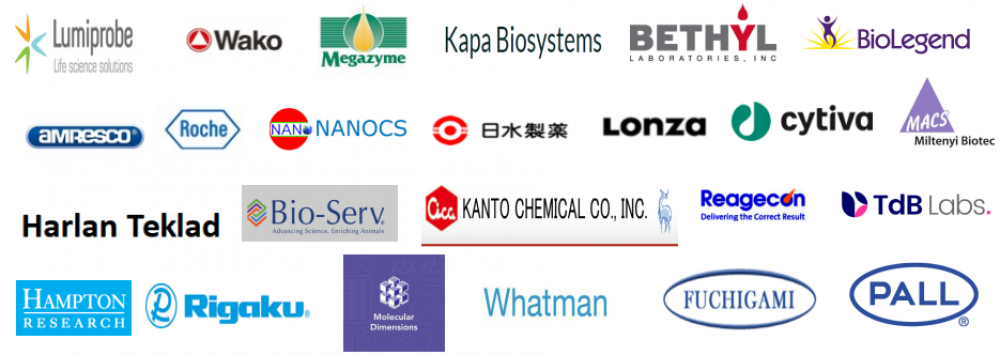Extracellular Matrix (ECM) 细胞外基质;Gelatin 明胶;Collagen Type I 胶原蛋白I型;Poly-L-lysine 多聚L-赖氨酸;Fibronectin 纤连蛋白;Matrigel 基质胶;CAS:9000-70-8;
| 产品名称 | 规格 | ||
| Gelatin, Type B 明胶(B型) | 100g |
基本介绍:
明胶(Gelatin)是一种由高平均分子量的水溶性蛋白组成的非匀质混合物,存在于胶原蛋白中。通过对皮肤、肌腱、韧带和骨头等组织煮沸后提炼所得。A型明胶(Type A Gelatin)来自酸水解的组织,B型明胶(Type B Gelatin)来自石灰水解的组织。
生物学研究,明胶的应用包括:1)包被细胞培养板以提高细胞的贴壁能力;2)加入PCR反应以稳定Taq DNA聚合酶活性;3)WB、ELISA和IHC实验中用作封闭剂;4)微生物学研究用作物种分化培养基组成成分之一;5)作为生物兼容性聚合物,明胶能用作运输载体来释放生化活性分子,或组织再生学中建立支架。工业领域,明胶的应用包括稳定剂、增稠剂和组织形成剂,用在食品中或橡胶替代品、粘合剂、水泥、平板印刷油墨、塑料、人造丝、照相底片和胶片等的生产制造中。医药工业中,明胶可用作助悬剂、包胶剂和药片粘合剂。兽医方面明胶可用作血浆扩容剂和止血剂。
本品以牛皮为原料,提炼自石灰水解组织所得,为B型明胶。本品以冻干粉形式提供,CAS NO:9000-70-8,凝胶强度~225 g Bloom,达细胞培养级别。用于细胞包被基质的推荐工作浓度为0.1-0.2 mg/cm2。
保存与运输方法:
保存:室温密封保存,数年稳定。
运输:室温运输。
注意事项
1)明胶冻干粉室温密封保存保持数年稳定。但在空气中加热到100°C,会膨胀变软,解聚产生一种碳质并伴随吡啶碱类和氨气的产生。<35-40°C明胶膨胀且吸收5~10倍体积的水产生凝胶。明胶溶于甘油和醋酸,在热水比冷水溶解性强。几乎不溶于大多数有机溶剂比如醇类、氯仿、二硫化碳、四氯化碳、酯类、苯类、酮类和油。
2)Bloom number由凝胶强度测定计(Bloom gelometer)测定,指的是从已知浓度溶液的成胶强度。Bloom number越高,凝胶越强。Bloom number与平均分子量成正比。
| Bloom number | Average molecular weight |
| 50-125 | 20,000-25,000 |
| 175-225 | 40,000-50,000 |
| 225-325 | 50,000-100,000 |
3)为了您的安全和健康,请穿实验服并戴一次性手套操作。
使用方法
一、明胶溶液的制备
1.1 明胶的溶解
根据实验所需的明胶浓度,称取适量明胶粉末,加入含双蒸水或PBS缓冲液的容器内,按照以下两种方法之一:1)明胶经10 min浸泡后,用热水浴加热(温度不要超过70℃),搅拌直至完全溶解;2)明胶经10 min浸泡后用小火加热(温度不要超过70℃),并不断搅拌直至完全溶解;
1.2 明胶的除菌
按照以下两种方法之一:
1)高压灭菌:将配好的明胶溶液(常用浓度0.1%~2.0%之间)装入瓶内,121℃,15 psi,高压灭菌20min;
2)滤膜除菌:低浓度明胶溶液(如0.1%或0.2%)溶解后可用0.2μm滤膜除菌。但需多准备几个滤器,因为明胶相对比较难过滤。
1.3 明胶的保存
明胶溶液稳定性比较高,置于4℃保存能长期保持稳定。【注意】:温度提高会明显降低明胶强度和粘度,导致性能降低。
二、明胶溶液的包被方法
具体的使用浓度和使用量依据细胞类型和实验目的而定。
2.1 用组织培养级别的水配制2%(w/v)的明胶溶液;
2.2 121℃,15 psi,高压灭菌20-30 min;
2.3 按照5-10 μL明胶溶液/cm2(或0.1-0.2 mg/cm2)的比例包被培养皿/板/瓶表面。充分覆盖包被表面。
2.4 放置37℃培养箱,至少干燥2h。吸掉多余明胶溶液,用培养基或PBS缓冲液清洗一遍,晾干后即可使用。
相关产品:
| Collagen, Type I, from Rat Tail 鼠尾胶原蛋白I | 2ml(10mg) | |
| Gelatin, Type A 明胶(A型) | 100g | |
| Gelatin, Type B 明胶(B型) | 100g | |
| Poly-L-lysine (Mw 70,000-150,000) 多聚L-赖氨酸 | 25mg | |
| Poly-L-lysine (Mw 150,000-300,000) 多聚L-赖氨酸 | 25mg | |
| Poly-D-lysine (Mw 70,000-150,000) 多聚D-赖氨酸 | 25mg | |
| Poly-L-lysine (Mw 150,000-300,000) 多聚L-赖氨酸 | 25mg | |
| Poly-D-lysine (Mw 150,000-300,000) 多聚D-赖氨酸 | 10mg | |
| Fibronectin from Human Plasma 人纤连蛋白 | 5mg | |
| Laminin from Mouse EHS sarcoma 小鼠层粘连蛋白 | 1mg |


